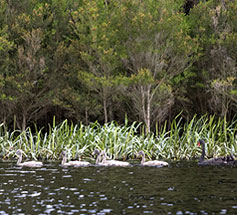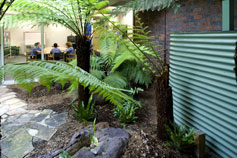YOU ARE HERE: CSE Report 2005 > Environment > Water Case Studies

Water Recycling Initiative at Port Kembla
Tube Mill Replacement Project
Sustainable Wastewater Recycling at Western Port
Water Recycling Initiative at Port Kembla
A recycling initiative between BlueScope Steel and Sydney Water Corporation will play a major role in preserving precious water supplies, while providing a significant environmental outcome for the Illawarra region of New South Wales, Australia.
Sydney Water Corporation's Illawarra Waste Water Strategy involved the consolidation of three sewage treatment plants - Port Kembla, Wollongong and Bellambi - at the Wollongong site. Following extensive consultation and design refinement of the Wollongong facility, BlueScope Steel entered into a 15 year contract with Sydney Water for the supply of 20 million litres of recycled water per day to the Port Kembla Steelworks and Springhill Works.
The recycled water is produced from the tertiary treated effluent from the new Wollongong facility by further purification using micro filtration and reverse osmosis technology. The resulting water is of similar chemical composition to that currently delivered to BlueScope Steel from Sydney Catchment Authority's dams.
The new Sydney Water facilities include a pipeline from the Wollongong treatment plant, through BlueScope Steel's property, to the Sydney Water industrial water reservoir at Berkeley.
The 20 million litres of recycled water is mixed with industrial water in the Berkeley Reservoir making a 55/45 mix of recycled and industrial water respectively. The water will be delivered to the Port Kembla Steelworks and Springhill Works sites through the existing dedicated industrial water supply system for use in a variety of industrial and environmental applications.
The recycled water scheme will reduce the fresh water demand from potable sources at the Port Kembla sites by more than 50 per cent. In addition, 20 million litres of waste water per day that would otherwise have been pumped into the ocean will be used on the Port Kembla sites.
This project complements an existing water reduction program that has seen water efficiency improve in the last 10 years from 5.5kl per slab tonne to 2.7kl per slab tonne (inclusive of recycled water and domestic water). When considering dam water use only, our efficiency is below 1.5 kl water per slab tonne.
Tube Mill Replacement Project
BlueScope Steel's Butler Manufacturing plant in Laurinburg, North America recently faced a challenge with outmoded equipment providing less than optimal environmental and production performance.
Butler Manufacturing's Building Systems division produces custom designed and pre-engineered one to eight-story steel frames and building systems for use as offices, manufacturing facilities, warehouses, schools, shopping centres, livestock, and farm buildings.
To produce the steel tubing that is a primary component in Butler's Truss Purlins, a structural component of roof systems, the Butler Laurinburg plant used an original Tube Mill dating back to around 1968. Very few upgrades to this particular Tube Mill line had occurred during its 40 year service in Laurinburg.
The aged equipment resulted in inefficiencies in productivity and high repair costs and had an undesirable environmental impact in the amount of water used. The original Tube Mill at Laurinburg had an open loop cooling system where water was used once and then sent down the drain.
The Laurinburg plant sought to replace the Tube Mill to improve its performance and reduce the environmental impact of the tube production line.
An existing Tube Mill was identified at Butler's plant in Galesburg that was only two years old and in production for approximately six months. The newer mill also had the capacity to run heavy material sizes with larger tube diameters. The existing Tube Mill at Laurinburg was removed and replaced with the equipment from Galesburg in June 2005.
The new Tube Mill uses a closed loop water cooling system where the water is recycled. This translates to a saving of approximately 40,000 gallons (151,000 litres) a day, 800,000 gallons (3.03 million litres) per month, or 9.6 million gallons (36.3 million litres) per year.
The Tube Mill project has had numerous benefits - improved productivity, reduced repair costs, spare equipment and a significant reduction in water consumption.
Sustainable Wastewater Recycling at Western Port
In June 2004, BlueScope Steel's Western Port Plant in Victoria began two energy efficiency feasibility projects. The projects were funded through the Victorian Government's Sustainable Energy Authority Business Energy Efficiency Initiative.
One of these projects - the Sustainable Liquid Waste Treatment - Cold Strip Plant Wastewater Treatment Plant Upgrade, is now in the detailed feasibility phase, and has the potential to help Western Port cut costs, operate more efficiently and contribute to a cleaner environment by reducing the amount of electricity and fresh water used at the plant. Additionally, there will be an increase in the amount of water recycled, and a reduction in licensed discharge of treated water into the bay at Western Port.
A key element of the project is to re-design the Waste Water Treatment Plant at Western Port, thereby:-
- Reducing the Western Port plant's fresh water intake by recovering a significant proportion of wastewater as high quality water suitable for recycling. This will also significantly reduce effluent discharge into the bay at Western Port. The amount of water recycled by this proposed project is equivalent to the fresh water needs of 1000 Victorian households.
- Reducing the cost of treating wastewater, providing significant operational savings.
- Significantly reducing prescribed industrial waste with the generation of a benign material that can be used in the fertiliser industry.
- Providing reductions in greenhouse gas emissions equivalent to removing 1000 cars from Victorian roads.
BlueScope Steel Western Port is now working with South East Water Limited, BlueScope Steel's fresh water provider, to develop this solution into a longer-term vision with practical sustainable outcomes, which will benefit both organisations in the future.

BlueScope Steel is actively pursuing strategies to reduce freshwater consumption and increase the use of recycled water.

The Western Port plant is reducing fresh water intake by recovering a significant proportion of wastewater as high quality water suitable for recycling.
